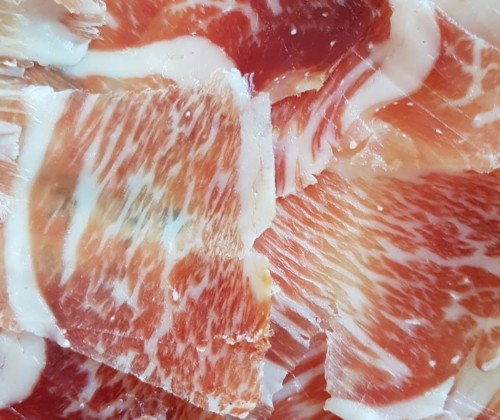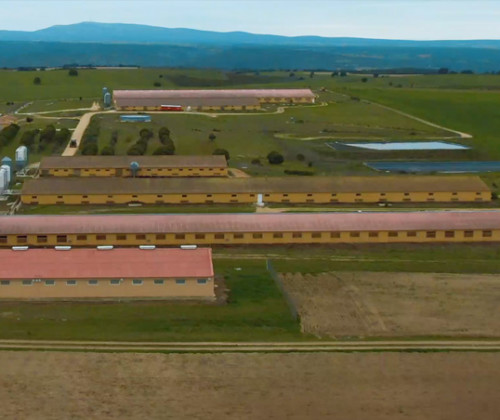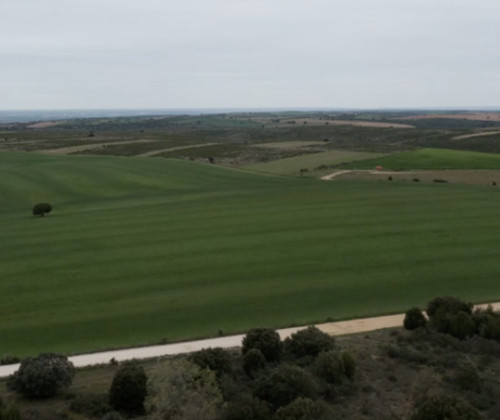The Duroc pig breed is becoming increasingly known because it is present in many of the cured products and sausages that we normally consume.
This breed also provides a high-quality meat that is perfect for producing fresh products such as the secreto, belly, loin… They are cuts that are highly valued by our consumers.
At ACH we have been genetically selecting the best Duroc pig specimens for more than 20 years. We are specialists in this breed.
Due to its genetic quality, the Duroc breed is ideal for crossbreeding it with the best Iberian pig strains that provide their products to the different Protected Designations of Origin. At Hermanos Chico Galindo we crossbreed the Duroc breed with both Iberian pigs and with our special selection of white breed pigs, this resulting in a pork with a unbeatable flavour characterised by its dark pink colour, juiciness and unique aroma.
Next, we will explain to you the different origins and characteristics of both breeds: Duroc and white coat pigs.

Differences between the Duroc breed and the white pig breeds
Duroc pigs
This breed was introduced in Spain in the 1960’s from the USA. It is the result of the crossbreeding between the Old Duroc and Red Jersey breeds. They are genetically closer to Iberian pigs than to white pig breeds.
They are medium-sized pigs, with a reddish coat, abundant red bristles, and forward leaning ears. Their trunk is medium-sized and arched, and they have long and fairly thin legs with strong black hooves.
They are being used as a finisher breed in the crossbreeding with white pig breeds, because it provides fat marbling, that makes the products improve their qualities and flavour.
It is the only breed whose crossbreeding with Iberian pigs is allowed according to the Iberian pig quality standard (Royal Decree no. 1469/2007, of 2 November): up to 50%, and always from the sire line.
Pork:
Its meat has a high degree of marbling, and juiciness, it has more fat streaks and a more intense flavour. It is very similar to that of Iberian pigs regarding its nutritional values and organoleptic qualities, although it is less fatty.
The greater marbling of the pork makes that the prime cuts (ham, loin and shoulder) are better regarding their processing and consumption, as in the case of the La Granja de Chico cured products.
The fresh pork is also tastier and tenderer because of this greater marbling.
White coat pigs
There are several white coat pig breeds, but the most frequent ones reared for human consumption are Landrace, Large White and Pietrain. These breeds have been genetically improved by the industry throughout time, and therefore the current specimens are very different from the original ones.
They are animals with thick and short legs, and with a pink or fair and delicate skin that becomes easily sunburnt.
Pork:
Domestic white pigs have lost their ability to accumulate fat, and they do not infiltrate it in their muscles. Therefore, their meat is leaner and not so tasty. They have a fat content of approximately 25%.
If we compare a white pig chop with a Duroc chop, we will see, at first sight, a greater marbling score in the case of the Duroc chop. It also does not lose water when we cook it and its meat is juicier.
At ACH we have specialised in the Duroc breed, that is perfect when used in the production of both Iberian pigs and white coat pigs.
In short, pork is a healthy food product that is suitable for all family members because it contains zinc, phosphorus and potassium as its more prominent minerals, and it is characterised by its vitamin B content (B1, B3, B6 and B12).
If you want to know about all the benefits provided by the consumption of pork, read our article.





